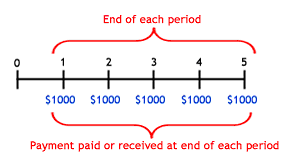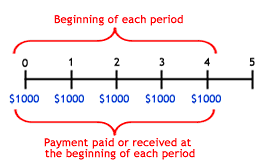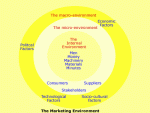Prof: – Prantik Ray
Attendees :- 189
Financial Mgmt. by definition is defined as Acquisition, Financing and Management of Assets to realize the short term/long terms goals of the firm.
Most folks started getting “”googlied” by this parlance and started to draw comparisons with Financial Accounting. Financial Accounting solely deals with reporting historical financial information. Financial Mgmt is purely a Managerial function tied with the future direction of the firm and hence has loads of decision making.
Financial Mgmt. has assumed significance because of Market Evolution, and hence more roles have been added to the umbrella Mgmt discipline, to include Risk Mgmt, Treasure Mgmt, Dividend Decisions and Mergers/Acquisitions.
So what are the decisions a Finance Manager make?
To summarize that, any firm needs sources of funds to utilize them towards the goals of the company. Hence a Finance Manager decides on how to source the funds, how to best utilize them for maximizing returns/ or whatever is in the best interests of the firm/shareholders. The decision making is aligned with the direction of the firm.
Decisions are
1. Investment Decisions (Project Valuation (Purely by discounted cash flow), Valuing Flexibility, Size of the firm, Assets Required, Assets to be avoided/eliminated). Capital Budgetting
2. Financing Decisions (How the Investment Decisions will be financed, best way of financing, dividend policies, how will the funds be acquired?). Capital Structure.
3. Net Working Capital Decisions
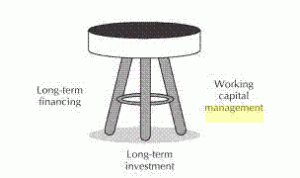
And lo…Here cometh our classic dividend discussions? Why and how should a company pay dividends? The dividend is calculated mainly on the basis of the company’s unappropriated profit and its business prospects for the coming year. If there are no major avenues to invest/park the profits, the management decides to return the exess to the investorts. In case of “Growth Stocks”, the company will retain the earnings internally to fund future growth. Hence it is purely company’s discretion to declare dividends, which again is a decision process keeping the long term interests in Mind. In India, a company has to pay taxes for dividends, while for the shareholders, the dividend income is tax-free. The company again may pay dividends in cash or share buybacks. These are better left to be dealt under Corporate Actions. For now, we should be fine understanding this as is. KG – Savvy?
3. Asset Management Decisions (Once the asset is on the books, how are they managed. Management of Current Assets over Fixed Assets)
Why should the focus be on managing current assets over fixed assets? – Once the decisions are made with respect to the Fixed assets (Thanks Aloke), there is nothing much a FM (like our Finance Minister) can do barring managing depreciation decisions/Tax Planning. It is the current assets which can/have to be managed/decided for better working results.
Goals of a Firm
Maximization of Shareholder Wealth – Value creation occurs on share price maximization.
Takes into account current and future profits and EPS, the timing, duration, and risk of profits and EPS, dividend policy, all other relevant factors.
Hence the share price serves as a barometer for business performance (ideally speaking)
A few alternative goals could be
1. Profit Maximization : – Maximizing the firm’s profits after taxes. It may not be appropriate because it does not consider the riskiness of returns and it ignores the timing of returns. e.g. If the firm operates in a perfectly competitive environment, the goal of profit maximization is not possible, while it is possible in a Monopoly. If the IT companies had Profit Maximization as the goal, it may not be possible to sustain because of increased competition, US Recession etc, and have to re-align the goals. TCS for e.g. has volume business (emphasis on Sales), while Infosys has Margin business (Emphasis on Profit Margins) to an extent though the goals may be different in each cases.
2. Earnings Per Share Maximization : –

Disadvantages to this
1. Not Time Bound/Ignores Long term risks
2. EPS can be maximized by reducing or nullifying dividends (above equation)
That said, a company’s goal can be different/unique.
Real world examples (as constantly asked in the class)
Dow Chemical Company: “maximize long-term shareholder value”
ExxonMobil: “long-term, sustainable shareholder value” (Though there is a recent and an interesting twist in this goal. Read http://www.ethicalmarkets.com/?p=700)
MODERN CORPORATION
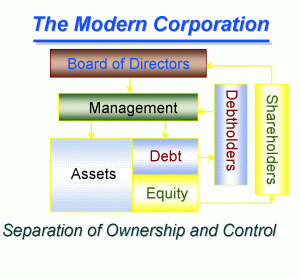
And voila… here comes the class stopper. The evergoing discussion on
1. Properietory : – A sole proprietor is not separate from the individual; what the business makes, so does the individual. Unlimited Liability. Single Taxation. Risks more. Issues in Transferring the Business. example. Your neighbourhood Tea Shop, Idli shop
2. Partnership : – A partnership is a type of business entity in which partners (owners) share with each other the profits or losses of the business undertaking in which all have invested. Favourable Taxation. Agreement is Required.
- Limited Liability Partnership : – A limited partnership is a form of partnership similar to a general partnership, except that in addition to one or more general partners (GPs), there are one or more limited partners (LPs).
- Limited Liability Limited Partnership (LLLP):- Very Recent in the US.
Examples include most law firms and CA firms in India.
3. Corporation : –
- Legal Entity to conduct business different from the “Owners”
- Limited Liability : End with Ltd., Inc., Plc etc (Shareholders and Employers not liable for Debt obligations)
- Unlimited Life : Going Concern Concept
- Pay Corporate Tax/Double Taxation
- Private Ltd and Public Ltd (By Type based on Public(equity) participation)
- Profit and Not-for-Profit (Again Types)
Examples Include Public Ltd : – Infosys Technologies Limited, NTPC Ltd
Private Ltd : – Sita Travels Pvt Ltd, KPN Travels Pvt Ltd
4. Limited Liability Company
- is a type of business ownership combining several features of corporation and partnership structures
- is not a corporation or a partnership
- owners are called members not partners or shareholders
- Limited Liability
- No Disclosure Required
- Better Taxation
- has issues to go public if decided later on
Examples : Most Real Estate Companies in the US (e.g Century 21 Real Estate, Coldwell Banker Real Estate)
Most modern day businesses are corporations with a clear demarcation between Owners and the Management.
Agency Theory : Principals (Owners) and Agents (Managers). Principals provide Incentives to Agents to work on their behalf. (Economics Theory)
Corporate Governance : – System through which Corporations are managed/controlled.
Organization of Finance Management : – VP Finance or CFO heading a team of Treasury and
Control Functions.
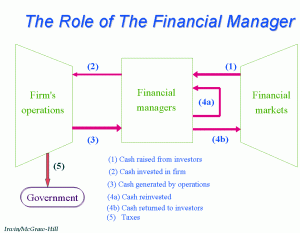
Markets can typically be
1. Equity or Debt and are contributed in turn by Savings from People, Companies and Government.



